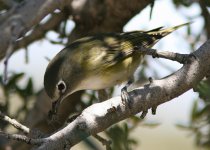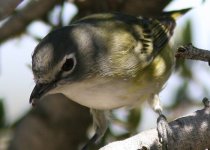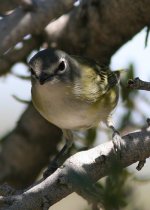-
Welcome to BirdForum, the internet's largest birding community with thousands of members from all over the world. The forums are dedicated to wild birds, birding, binoculars and equipment and all that goes with it.
Please register for an account to take part in the discussions in the forum, post your pictures in the gallery and more.
You are using an out of date browser. It may not display this or other websites correctly.
You should upgrade or use an alternative browser.
You should upgrade or use an alternative browser.
Blue-headed Vireo? LV, NV (1 Viewer)
- Thread starter LzyPhotographer
- Start date
More options
Who Replied?AmpelisChinito
Cedar Waxwing Chairman
Correct.
I agree with KC. They are probably my favourite vireo, though I find it tough to get decent photos of them. Yours, however, are great!
I hear you Gillian, has to be my favorite as well - such a beauty! Agree fantastic photos Maureen ! :t:
prairiemerlin
registered guy
I hate to be a wet blanket, but I'm not sure if Cassin's Vireo can be ruled out. Sure, it does seem rather bright for a Cassin's, but they can be quite bright, especially when in fresh basic plumage. The two species are extremely similar (I believe the Solitary Vireo complex to be underrated, identification wise), and there is some overlap and intergrades. Lastly, Blue-headed would be very unusual in Nevada, so the bird should be very closely studied. To quote Mr. Sibley:
The three species in the Solitary Vireo complex are rather poorly differentiated... intermediate birds (and perhaps hybrids) should be expected, and not every individual will be identifiable.
Neil
The three species in the Solitary Vireo complex are rather poorly differentiated... intermediate birds (and perhaps hybrids) should be expected, and not every individual will be identifiable.
Neil
Gentoo
Guest
I was thinking that oo although Vireo's are not my strong point visually.I hate to be a wet blanket, but I'm not sure if Cassin's Vireo can be ruled out. Sure, it does seem rather bright for a Cassin's, but they can be quite bright, especially when in fresh basic plumage. The two species are extremely similar (I believe the Solitary Vireo complex to be underrated, identification wise), and there is some overlap and intergrades. Lastly, Blue-headed would be very unusual in Nevada, so the bird should be very closely studied. To quote Mr. Sibley:
The three species in the Solitary Vireo complex are rather poorly differentiated... intermediate birds (and perhaps hybrids) should be expected, and not every individual will be identifiable.
Neil
daimyo
Active member
Tough ID. The 3rd photo doesn't show a clean contrast between the white throat and slate-blue "helmet" that I would expect from a Blue-headed. Cassin's are in fresh plumage in the fall and some birds are very bright. I agree with Prairiemerlin that Cassin's is still a possibility. Maybe other photos will shed more light.
JANJ
Well-known member
On range perhaps more likely a Cassin´s but as mentioned here - problematic identification issue, and images not making things easier, in spite of Maureens very good ones.
It has been suggested that the dark loral mark could be a fairly good separating feature, as dark as the head in Blue-headed, creating no, or little contrast, obvious contrast in Cassin´s.
http://montereybay.com/creagrus/sovi-id-comm.html
However, this would in a field situation - and def. in images, be quite difficult to put to much trust into due to variation and light.
http://www.pbase.com/ne_wildlife_photography/image/51446470
Compare also with KC,s excellent image here, which is a sure Blue-headed on rage:
http://www.pbase.com/kcfoggin/image/72355592
Note lack of obvious contrast - auriculars and throat:
http://www.pbase.com/kcfoggin/image/91506339
Check the Vireo section in Martin Reids site:
http://www.martinreid.com/Main website/obidind.html
Cassin´s:
http://www.pbase.com/clinton62/image/81196788
http://www.pbase.com/clinton62/image/82382150
http://www.pbase.com/silverbowff/image/75492520
JanJ
It has been suggested that the dark loral mark could be a fairly good separating feature, as dark as the head in Blue-headed, creating no, or little contrast, obvious contrast in Cassin´s.
http://montereybay.com/creagrus/sovi-id-comm.html
However, this would in a field situation - and def. in images, be quite difficult to put to much trust into due to variation and light.
http://www.pbase.com/ne_wildlife_photography/image/51446470
Compare also with KC,s excellent image here, which is a sure Blue-headed on rage:
http://www.pbase.com/kcfoggin/image/72355592
Note lack of obvious contrast - auriculars and throat:
http://www.pbase.com/kcfoggin/image/91506339
Check the Vireo section in Martin Reids site:
http://www.martinreid.com/Main website/obidind.html
Cassin´s:
http://www.pbase.com/clinton62/image/81196788
http://www.pbase.com/clinton62/image/82382150
http://www.pbase.com/silverbowff/image/75492520
JanJ
Last edited:
Excellent links as usual Jan. I do not have much experience with Cassin's Vireo, so do not have an opinion on this bird, but it certainly looks like a very tricky affair to identify an out of range Cassin's or Blue-headed. I thought I would highlight this passage from Jan's first link, which also confirms what daimyo and Neil noted:
Jim
According to Pyle's banding guide (1997), all adults [of the Solitary Vireo complex] molt on the breeding grounds and thus should be most fresh and colorful in the fall and early winter, with little or no spring molt. Birds should be the dingiest in summer or late spring. My impression in California has been that there have been a fair number of mistaken claims on "Blue-headed" (esp. in winter) because some observers are not aware of the molt schedule and note that the winter birds look "bright" compared to the summer breeders. My other impression from California is that all the vagrants found by more experienced types are invariably rather obvious birds. This makes me believe we are probably overlooking the "dull end" of Blue-headed here among the bright fall & early winter Cassin's. [I also think some correct Blue-headed claims have been rejected by rarity committees because the written details lack the "pet" marks that some members seem to require, notwithstanding the observer's expertise in general.]
My final thought from this experience is that sometimes we say "only extreme birds" can be identified as vagrants when what is actually meant is that "only typical birds" are identifiable as vagrants. I think most Blue-headeds are straight-forward (at least in fall) because a good chunk of the population is "typical" and bright and contrasty (like the photos on this page). But western populations of Blue-headed may be less obvious and more difficult to confirm when seen as vagrants, and caution is always warranted with such intermediate types.
Best,My final thought from this experience is that sometimes we say "only extreme birds" can be identified as vagrants when what is actually meant is that "only typical birds" are identifiable as vagrants. I think most Blue-headeds are straight-forward (at least in fall) because a good chunk of the population is "typical" and bright and contrasty (like the photos on this page). But western populations of Blue-headed may be less obvious and more difficult to confirm when seen as vagrants, and caution is always warranted with such intermediate types.
Jim
Last edited:
LzyPhotographer
Well-known member
Updated Gallery for mystery Vireo
There's been more votes for Blue-headed than Cassin's, so I've uploaded all the pics of the Vireo to a new gallery for those who wanted to see more. Both birds are new to me, so I luck out either way. ;-)
Each image is cropped & slightly focused only - NO adjustments to light/contrast or color. That means overall the colors are muted, in bright light washed out and in shadow it picks up noise.
Taken on Macks Canyon Rd, in Lee Canyon/Spring Mts, at about 8000 ft. I think.
http://www.lazyphotographer.com/coppermine/thumbnails.php?album=129
Thanks!
Maureen
There's been more votes for Blue-headed than Cassin's, so I've uploaded all the pics of the Vireo to a new gallery for those who wanted to see more. Both birds are new to me, so I luck out either way. ;-)
Each image is cropped & slightly focused only - NO adjustments to light/contrast or color. That means overall the colors are muted, in bright light washed out and in shadow it picks up noise.
Taken on Macks Canyon Rd, in Lee Canyon/Spring Mts, at about 8000 ft. I think.
http://www.lazyphotographer.com/coppermine/thumbnails.php?album=129
Thanks!
Maureen
Chris Benesh
So much work, so little time...so let's go birding
There's been more votes for Blue-headed than Cassin's, so I've uploaded all the pics of the Vireo to a new gallery for those who wanted to see more. Both birds are new to me, so I luck out either way. ;-)
Hi Maureen,
Thanks for posting the additional images. I completely agree with the conservative approach first voiced by Neil and echoed most eloquently by the Peter Pyle quote posted by Jim. The "Solitary" Vireos are a real mess on several levels. Not only do the populations in the US and Canada have real ID issues, but on top of that, there are more populations in Mexico and northern Central America that muddle things even more. I really do wonder if this split will hold up to the test of time. I realize that defining species limits is not simply about whether or not one can identify individuals, but several of the populations in this complex were more or less ignored when defining these new limits. I have certainly seen really bright fall Cassin's in the west coast over the years, and I have also seen worn, dull Blue-headed Vireos in Nova Scotia that might well have been identified as Plumbeous Vireos if they had been seen in the west. I also routinely have discussions with other birders over whether an individual bird in the field is a Cassin's or Plumbeous. So it is messy, and is particularly challenging to identify out-of-range candidates.
That said, your pictures look fine for Cassin's, and the ones in full sun especially impart a Cassin's feel to them. On the other hand, if this bird was to be seen in the east, it would be identified as a Blue-headed without much thought probably.
Chris
JANJ
Well-known member
"That said, your pictures look fine for Cassin's, and the ones in full sun especially impart a Cassin's feel to them. On the other hand, if this bird was to be seen in the east, it would be identified as a Blue-headed without much thought probably"
You see, a total mess.
JanJ
You see, a total mess.
JanJ
atricapillus
Well-known member
"That said, your pictures look fine for Cassin's, and the ones in full sun especially impart a Cassin's feel to them. On the other hand, if this bird was to be seen in the east, it would be identified as a Blue-headed without much thought probably"
You see, a total mess.
JanJ
Not sure I would call it a total mess. I would have argued for Cassin's on the NV bird Chris apparently found so obvious. It has a soft boundary on throat, a paler gray cap (not as slaty gray as that of Blue-headed) and intermixed with some green, off-white spectacles and throat, gray rather than blackish in superciliary. The bill is on the small side, although not as obvious a difference as with Plumbeous Vireos that are larger billed. The one unusual trait for Cassin's seems to be the brightness of the yellow in the sides. Some imm female Blue-headeds can intermix some green in the cap, but they usually have a low contrast plumage but with some brown wash reflecting hatch-year age, and come closest to similar age/sex Cassin's.
Given Chris' comment IDing from where it was seen, was wondering if he could offer a comment on KC's vireo from SC in winter.
http://www.pbase.com/kcfoggin/image/91506339
CHEERS, JOE
Users who are viewing this thread
Total: 2 (members: 0, guests: 2)







